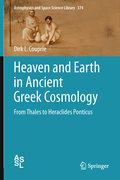
Heaven and earth in ancient greek cosmology: from thales to heraclides ponticus
Couprie, Dirk L.
In Miletus, about 550 B.C., together with our world-picture cosmology was born. This book tells the story. In Part One the reader is introduced in the archaic world-picture of a flat earth with the cupola of the celestial vault onto whicháthe celestial bodies are attached. One of the subjects treated in that context is the riddle of the tilted celestial axis. This part also contains an extensive chapter on archaic astronomical instruments.áPart Twoáshows how Anaximander (610-547 B.C.) blew up this archaic world-picture and replaced it by anew one that is essentially still ours. He taught that the celestial bodies orbit at different distances and that the earth floats unsupported in space. This makes him the founding father of cosmology.áPart Threeádiscusses topics that completed the new pictureádescribed by Anaximander. Special attention is paid to the confrontation between Anaxagoras and Aristotle on the question whether the earth is flat or spherical, and on the battleábetween Aristotle and Heraclides Ponticus on the question whether the universe is finite or infinite. Contains over one hundred pictures to elucidate the text, many of which are originally drawn by the author. Provides readers with a comprehensive treatment of archaic astronomical instruments and groundbreaking interpretations forhow they might have been used. Provides dozens of challenging new interpretations and historical perspectives on ancient Greek cosmology. INDICE: The Archaic World-Picture. Archaic Astronomical Instruments. How Thales Was Able to Predict the Solar Eclipse of 28 May 585 B.C. The Shape of the Earth According to Thales. The Riddle of the Celestial Axis. The First Map of the Earth. Anaximander, and the Discovery of Space. Anaximander, A Survey ofhis Ideas. The Discover of Space: Anaximander’s Cosmology. Anaximander’s Numbers: The Dimensions of the Universe. The Visualization of Anaximander’s World-Picture. Bellows or Lightning? A Curious Terminology Explained. Critique of anAlleged Cosmic Architecture. A Survey from Anaximander to Aristarchus. With Fear For His Own Life: Anaxagoras as a Cosmologist. The Sun at the Horizon: Anaxagoras’ Argument for a Flat Earth. The Sun is as Big as the Peloponnesus. TheDodecahedron, or the Shape of the Earth According to Plato. Fear of Falling: Aristotle on the Shape of the Earth. Heraclides Ponticus and the Infinite Universe.-.
- ISBN: 978-1-4419-8115-8
- Editorial: Springer New York
- Encuadernacion: Cartoné
- Páginas: 302
- Fecha Publicación: 29/03/2011
- Nº Volúmenes: 1
- Idioma: Inglés
